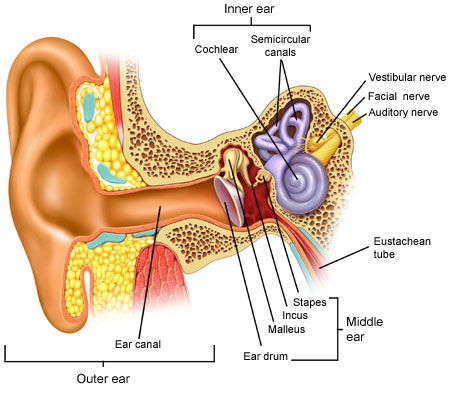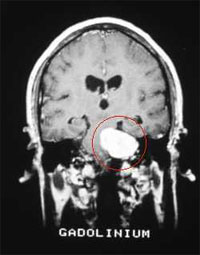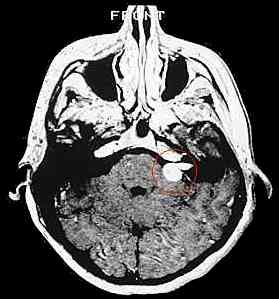Retrocochlear disorder is a disorder occurring at the central or neural nerve that causes hearing impairment. Among the causes of retrocochlear disorder include infections, tumors, head trauma, inflammation, vascular disorders and neurological problem. Diagnosis of a retrocochlear disorder usually involve the presence of a tumour like an acoustic neuroma etc.
Sensorineural hearing loss is a common disorder that results from damage to the inner ear.
Retrocochlear disorder is quite rare and can not be differentiated through clinical symptoms only. Symptoms related with other vestibular and neurological diseases need to be detected and ruled out prior, using appropriate diagnostic tools.
Acoustic neuroma is the main cause of retrocochlear disorders and require careful surgery in order to preserve one’s residual hearing and facial nerve function.
 |
Definition and Location
Retrocochlear means beyond the cochlear. Retrocochlear disorder is a disorder that occur beyond the cochlear, ie either at the auditory nerve or/and cerebellopontine angle.
There are also opinions claiming that retrocochlear disorders may occur at the auditory nerve level, area of brain that processes speech or at other areas of the central auditory system.
Other names for retrocochlear disorder :
- Retrocochlear lesion
- Retrocohlear hearing loss
- Vestibulocochlear disease
Symptoms
- Unilateral or asymmetric hearing loss
- Unilateral or asymmetric tinnitus
- Poor sound quality at one ear
- Difference in sound quality at both ears
- Vertigo or dizziness
- Fullness of the ear
- Difficulty hearing in noise
- Poor speech discrimination
Diagnostic tools
One of the diagnostic tools used to diagnose retrocochlear disorder is the Magnetic Resonance Imaging (MRI). MRI uses strong magnetic field and radio waves to capture specific brain images and its fine inner structures. MRI is not painful and does not involve any surgery. With MRI, doctors can determine whether a retrocochlear disorder is present or not. If a retrocochlear disorder is present, doctors can identify the pathology; either caused by tumour, inflammation, vascular disease or neurological problem.
Besides MRI, hearing assessments play an important role in identifying retrocochlear disorder. This is because one of the main symptoms of retrocohlear disorder is hearing loss. For example, if a tumor is identified to be present through MRI, the hearing level of both ears must be obtained prior to any treatment administered to the patient.
Other audiological tests to rule out any retrocochlear disorder :
- Auditory Brainstem Response test (ABR)
- Otoacoustic Emissions test (OAE)
- Acoustic reflex test
- Reflex decay test
Treatment and Rehabilitation
Treatment will vary greatly depending on the pathology causing the retrocochlear disorder.
If the retrocochlear disorder is caused by a tumour, treatment are as follows:
- Observation (Wait and see) : If size of tumour is small (less than 1.5cm), elderly age group or very little symptoms present.
- Radiotherapy : If tumour is small or medium in size. The purpose of radiotherapy is to destroy the tumour cells or make it smaller
- Surgery : If tumour is big (more than 2.5cm), the patient is advised to undergo surgery. The purpose of surgery is to remove the tumour while preserving the hearing and facial nerve function.
If the retrocochlear disorder is caused by any infection or inflammation, treatment used are usually antibiotics. For multiple sclerosis and vascular lesions at the vertebral artery and its branches, treatment will need a multidisciplinary approach.
For rehabilitation approach, especially for pediatrics cases, amplification such as hearing aids and cochlear implants, together with speech therapy are recommended. For adult cases, amplifications such as hearing aids and cochlear implants are also recommended.
 |
 |
Effects of retrocochlear disorder
- Difficulty to hear in one ear due to damage at the auditory nerve
- Ringing in the ear
- Facial nerve palsy due to damage at the facial nerve
- Numbness of face
- Imbalance problem
Seek treatment
For any enquiries or advice regarding retrocochlear disorder, do contact or go to your nearest Otorhinolaryngology (ORL) clinic at any government hospital nearby.
| Semakan akhir | : | 29 Januari 2014 |
| Writer | : | Amirudin b. Mohamed |
| Translator | : | Nor Hidayah bt. Mohd Hatta |
| Accreditor | : | Siti Suriani bt. Che Hussin |







